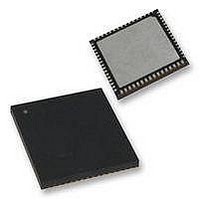PIC24FJ64GA106-E/MR Microchip Technology, PIC24FJ64GA106-E/MR Datasheet - Page 212

PIC24FJ64GA106-E/MR
Manufacturer Part Number
PIC24FJ64GA106-E/MR
Description
16-bit, 16 MIPS, 64KB Flash, 16Kb RAM, 84 I/O, NanoWatt 64 QFN 9x9x0.9mm TUBE
Manufacturer
Microchip Technology
Series
PIC® 24Fr
Datasheet
1.PIC24FJ128GA106-IPT.pdf
(330 pages)
Specifications of PIC24FJ64GA106-E/MR
Core Processor
PIC
Core Size
16-Bit
Speed
32MHz
Connectivity
I²C, IrDA, LIN, SPI, UART/USART
Peripherals
Brown-out Detect/Reset, LVD, POR, PWM, WDT
Number Of I /o
53
Program Memory Size
64KB (22K x 24)
Program Memory Type
FLASH
Ram Size
16K x 8
Voltage - Supply (vcc/vdd)
2 V ~ 3.6 V
Data Converters
A/D 16x10b
Oscillator Type
Internal
Operating Temperature
-40°C ~ 125°C
Package / Case
*
Processor Series
PIC24FJ256GA110
Core
PIC
Data Bus Width
16 bit
Data Ram Size
16 KB
Interface Type
UART, I2C, SPI
Maximum Clock Frequency
8 MHz
Number Of Timers
5
Operating Supply Voltage
3.6 V
Maximum Operating Temperature
- 40 C to + 85 C
Mounting Style
SMD/SMT
Lead Free Status / RoHS Status
Lead free / RoHS Compliant
Eeprom Size
-
Lead Free Status / Rohs Status
Details
- Current page: 212 of 330
- Download datasheet (3Mb)
PIC24FJ256GA110 FAMILY
19.1
The RTCC module registers are organized into three
categories:
• RTCC Control Registers
• RTCC Value Registers
• Alarm Value Registers
19.1.1
To limit the register interface, the RTCC Timer and
Alarm Time registers are accessed through corre-
sponding register pointers. The RTCC Value register
window (RTCVALH and RTCVALL) uses the RTCPTR
bits (RCFGCAL<9:8>) to select the desired Timer
register pair (see
By writing to the RTCVALH byte, the RTCC Pointer
value, RTCPTR<1:0> bits, decrement by one until they
reach ‘00’. Once they reach ‘00’, the MINUTES and
SECONDS value will be accessible through RTCVALH
and RTCVALL until the pointer value is manually
changed.
TABLE 19-1:
The Alarm Value register window (ALRMVALH and
ALRMVALL)
(ALCFGRPT<9:8>) to select the desired Alarm register
pair (see
By writing to the ALRMVALH byte, the Alarm Pointer
value, ALRMPTR<1:0> bits, decrement by one until
they reach ‘00’. Once they reach ‘00’, the ALRMMIN
and ALRMSEC value will be accessible through
ALRMVALH and ALRMVALL until the pointer value is
manually changed.
DS39905E-page 212
RTCPTR
<1:0>
00
01
10
11
RTCC Module Registers
Table
REGISTER MAPPING
19-2).
uses
Table
RTCVAL<15:8>
RTCVAL REGISTER MAPPING
RTCC Value Register Window
WEEKDAY
MINUTES
MONTH
19-1).
—
the
ALRMPTR
RTCVAL<7:0>
SECONDS
HOURS
YEAR
DAY
bits
TABLE 19-2:
Considering that the 16-bit core does not distinguish
between 8-bit and 16-bit read operations, the user must
be aware that when reading either the ALRMVALH or
ALRMVALL bytes will decrement the ALRMPTR<1:0>
value. The same applies to the RTCVALH or RTCVALL
bytes with the RTCPTR<1:0> being decremented.
19.1.2
In order to perform a write to any of the RTCC Timer
registers, the RTCWREN bit (RCFGCAL<13>) must be
set (refer to
EXAMPLE 19-1:
asm volatile("disi #5");
__builtin_write_RTCWEN();
ALRMPTR
Note:
Note:
<1:0>
00
01
10
11
This only applies to read operations and
not write operations.
WRITE LOCK
To avoid accidental writes to the timer, it is
recommended that the RTCWREN bit
(RCFGCAL<13>) is kept clear at any
other time. For the RTCWREN bit to be
set, there is only 1 instruction cycle time
window allowed between the unlock
sequence and the setting of RTCWREN;
therefore, it is recommended that code
follow the procedure in
For applications written in C, the unlock
sequence should be implemented using
in-line assembly.
Example
ALRMVAL<15:8> ALRMVAL<7:0>
ALRMVAL REGISTER
MAPPING
Alarm Value Register Window
ALRMMNTH
ALRMMIN
ALRMWD
19-1).
SETTING THE RTCWREN
BIT
2010 Microchip Technology Inc.
—
Example
ALRMSEC
ALRMDAY
ALRMHR
—
19-1.
Related parts for PIC24FJ64GA106-E/MR
Image
Part Number
Description
Manufacturer
Datasheet
Request
R

Part Number:
Description:
Manufacturer:
Microchip Technology Inc.
Datasheet:

Part Number:
Description:
Manufacturer:
Microchip Technology Inc.
Datasheet:

Part Number:
Description:
Manufacturer:
Microchip Technology Inc.
Datasheet:

Part Number:
Description:
Manufacturer:
Microchip Technology Inc.
Datasheet:

Part Number:
Description:
Manufacturer:
Microchip Technology Inc.
Datasheet:

Part Number:
Description:
Manufacturer:
Microchip Technology Inc.
Datasheet:

Part Number:
Description:
Manufacturer:
Microchip Technology Inc.
Datasheet:

Part Number:
Description:
Manufacturer:
Microchip Technology Inc.
Datasheet:










